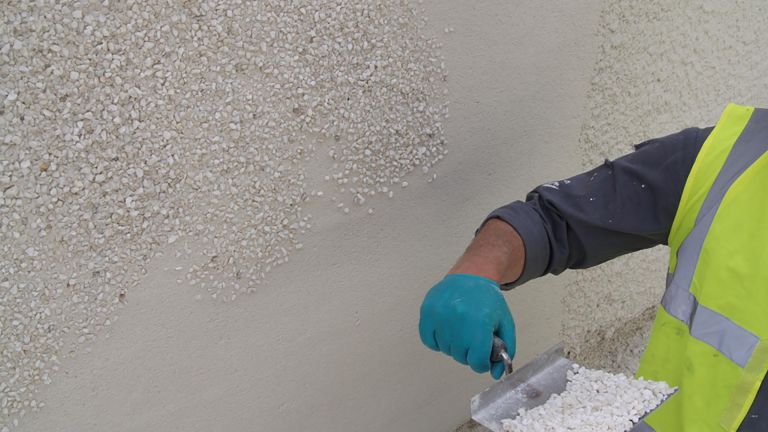Sand and cement rendering is a popular approach utilized in construction and domestic improvement to create a durable and aesthetically alluring exterior end for partitions. This time-tested approach combines sand, cement, and water to create a clean or textured floor on brick, block, or stone walls. Whether you’re seeking to enhance the appearance of your house, guard it from the factors, or really update an vintage exterior, sand and cement rendering offers an low-priced and flexible answer.
In this newsletter, we can cowl the basics of sand and cement rendering, how it works, the benefits it gives, and the step-by-step technique concerned in applying it.
What Is Sand and Cement Rendering?
Rendering is a kind of plastering that is implemented to the outdoors of homes. It entails making use of a mixture of sand, cement, and water (and every so often lime or additives) to the floor of a wall. The purpose is to enhance the cultured attraction, add texture, and offer protection from weathering and moisture.
Sand and Cement Rendering mainly refers to a render made with sand and cement because the number one components. This form of render is commonly implemented in several layers and may be finished with a number of textures or left clean depending on the preferred appearance.
How Does Sand and Cement Rendering Work?
The method of rendering includes applying a moist combination of sand, cement, and water to the outdoors walls of a building. Here’s a breakdown of the way it really works:
- Preparation of the Surface: Before applying the render, the wall floor have to be wiped clean and prepped. This frequently involves getting rid of dust, debris, and any unfastened substances to make certain proper adhesion. Sometimes, a bonding agent can be used to enhance the grip among the wall and the render.
- Mixing the Render: The traditional sand and cement render mix includes:
- Sand: Usually best sharp sand, which offers the render texture and sturdiness.
- Cement: Provides the electricity and bonding homes.
- Water: Helps bind the substances together and guarantees the mixture is achievable. The ratio of sand to cement can range depending on the desired electricity and end. A commonplace ratio is four:1 (4 parts sand to one part cement), although it can be adjusted for special programs.
- Applying the Render: The render is applied in layers, starting with a tough base coat, followed by way of a completing coat. The base coat allows the render adhere to the surface, whilst the topcoat affords the very last end. The render is unfold evenly with a trowel, and each layer is allowed to remedy earlier than the subsequent is carried out.
- Finishing the Surface: After the render has been carried out and has set to a possible country, it may be smoothed or textured relying on the desired appearance. Common finishes encompass:
- Smooth Finish: Achieved through smoothing the floor with a float or trowel for a easy, present day look.
- Textured Finish: A greater rustic appearance, in which a brush or sponge is used to create styles or textures inside the surface.
- Tiled or Patterned Finish: Some human beings opt for a patterned end the usage of various gear for ornamental outcomes.
- Curing: The render desires time to therapy nicely. While it’ll set quick, it should be allowed to remedy slowly over a length of several days, with occasional misting to save you it from drying too rapid and cracking.
Benefits of Sand and Cement Rendering
- Durability and Strength: Sand and cement render affords a difficult-sporting, long lasting surface that can face up to harsh weather situations, inclusive of rain, wind, and solar. It facilitates defend the constructing’s structural elements from water penetration and harm, which is mainly important in areas with excessive moisture or fluctuating temperatures.
- Improved Aesthetic Appeal: Sand and cement rendering can drastically improve the arrival of a building. Whether you select a smooth, polished end or a textured one, rendering creates a easy, uniform appearance. It can also be painted in any shade to suit the building’s design.
- Protection Against Weathering: One of the primary features of sand and cement rendering is to shield the underlying structure. The render facilitates keep out moisture and stops water from getting into the constructing’s walls, which can purpose dampness, mildew, or even structural damage over the years.
- Cost-Effective: Compared to other exterior finishes like cladding or herbal stone, sand and cement rendering is fairly affordable. It is also easy to preserve and restore, which makes it a cost-effective lengthy-time period solution for enhancing the outside of a constructing.
- Versatility: Sand and cement rendering may be used on a number of surfaces, together with brick, block, concrete, or even foam insulation panels. It additionally lets in for a number decorative finishes, so it can be adapted to distinctive architectural styles.
Applications of Sand and Cement Rendering
- Residential Homes: Sand and cement rendering is commonly used on the exterior of residential homes to improve cut back enchantment, add texture, and offer weather protection. It is particularly famous in coastal regions wherein homes are exposed to harsh climate situations, because the render allows to protect partitions from the factors.
- Commercial Buildings: Many industrial homes also gain from sand and cement rendering, specifically while a current, smooth appearance is preferred. The versatility of render allows corporations to create custom finishes that align with their emblem or aesthetic.
- Renovations: When renovating older buildings, applying sand and cement render can refresh the outdoors and improve insulation, whilst additionally offering a cutting-edge end to worn-out, worn surfaces.
- External Features: In addition to walls, sand and cement render can be used for other exterior factors, including chimneys, lawn walls, keeping partitions, and outside functions, helping to give them a cohesive appearance and introduced durability.
Step-by using-Step Guide to Sand and Cement Rendering
If you’re interested by applying sand and cement render your self, here’s a wellknown overview of the steps worried:
- Prepare the Surface: Clean the wall and put off any particles. If the floor is rough or porous, observe a bonding agent to assist the render adhere better.
- Mix the Render: Combine the sand and cement in a 4:1 ratio (sand to cement) and add water to reap a attainable consistency. Mix very well to ensure the combination is easy and free of lumps.
- Apply the Base Coat: Use a trowel to spread the render evenly over the wall. Apply a skinny base coat (round 8-10mm thick) and permit it to dry for some hours. This coat need to be rough enough to ensure the completing layer sticks properly.
- Apply the Topcoat: Once the bottom coat has dried, practice the finishing coat the usage of the same technique. The finishing layer may be smoother or textured, relying in your desired final results. Allow the render to set for numerous hours.
- Finish the Surface: Once the top layer is dry but nonetheless barely damp, use a trowel or float to easy the floor or create your favored texture.
- Curing: Let the render cure slowly over some days. Mist it with water sometimes to save you speedy drying, which can purpose cracking.
Conclusion
Sand and cement rendering is a highly effective and flexible method for improving the outdoors appearance and durability of buildings. Its blessings encompass expanded climate protection, better aesthetics, and price-effectiveness. Whether you’re tackling a DIY assignment or hiring a expert, making use of sand and cement render can transform the appearance and capability of your property or industrial property.
By following right instruction and application strategies, you could obtain an extended-lasting, visually appealing end with a view to rise up to the elements and improve your private home’s cost.


